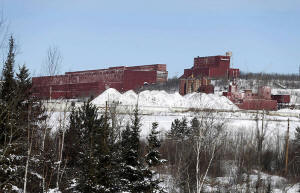Trump makes US copper mining a focus of his domestic minerals policy
[February 28, 2025] By
MEAD GRUVER
CHEYENNE, Wyo. (AP) — President Donald Trump is taking a step toward
granting the U.S. mining industry’s biggest wishes by singling out one
metal as a focus of his domestic minerals policy: copper.
From talk of acquiring Greenland and its vast mineral wealth to prodding
Ukraine for minerals in exchange for help fending off Russia's invasion,
Trump has made the raw materials of modern life a pillar of his foreign
policy.
An executive order Trump signed Tuesday calls for boosting the domestic
copper industry by investigating the national security implications of
imports and weighing tariffs as a response.
“The United States has ample copper reserves, yet our smelting and
refining capacity lags significantly behind global competitors,” the
order reads.
It could mean a new day for U.S. copper mining, and new worries for
environmental groups that are contesting proposals such as the stalled
Twin Metals project in northern Minnesota's Boundary Waters, a
lake-filled wilderness on the U.S.-Canada border.
“The White House itself acknowledges that America has ‘ample supplies’
of copper. Sacrificing an irreplaceable national treasure for an
insignificant amount of copper is reckless and unnecessary,” Ingrid
Lyons, executive director of the Save the Boundary Waters, said by
email.

Copper is in demand
Copper is at least as crucial as lithium and cobalt for rechargeable
batteries and rare-earth elements for cellphones, LED lights and
flat-screen TVs. Copper goes into the cords and transmission lines that
plug gadgetry into power.
“Copper is, I think, the metal that is really the most critical because
it is the electricity metal,” said Debra Struhsacker, a mining industry
policy consultant. “The electricity demand is, I think, going to stay.
And copper is indispensable for that.”
U.S. copper use, imports and exports have fluctuated somewhat over the
past two decades, according to the Copper Development Association, but a
dearth of smelting compared with the amount mined domestically has
remained a consistent theme.
Where does the U.S. get its copper?
While the U.S. in 2024 mined an estimated 1.1 million tons (1 million
metric tons) of copper and exported about a third of that in primarily
unrefined form, it imported 810,000 tons (735,000 metric tons), nearly
all of it refined, according to the U.S. Geological Survey.
Trump's executive order accurately refers to China as the world's
leading refiner of copper, with over half the world's smelting capacity.
China, however, does not directly factor into U.S. supplies. Two-thirds
of U.S. imports of refined copper comes from Chile, which is the world's
leading copper producer, with lesser amounts from Canada, Mexico and
Peru.
How much those numbers might change with rising copper demand to support
construction of transmission lines and manufacturing of wind turbines
and electric vehicles remains to be seen. Some predict global demand to
double by 2030 and keep rising, notes the National Mining Association.
Even before Trump's plan for copper, the association was encouraged by
Trump executive orders promoting mining. One lifts government rules and
regulations responsible for “undue burdens” on mining and mineral
processing, calls for updating the U.S. Geological Survey's list of
minerals deemed critical to the nation and backs efforts to find and
mine new sources of those minerals.
[to top of second column] |

The closed LTV Steel taconite plant sits idle near Hoyt Lakes,
Minn., Feb. 10, 2016. (AP Photo/Jim Mone, File)
 “Made in America, America first,
starts with American mining and American miners that supported this
president across the country,” National Mining Association president
and CEO Rich Nolan said.
Copper projects have faced delays
The mining association's top priorities include:
— The planned $1.7 billion Twin Metals
copper-nickel-cobalt mine that environmental groups contend poses an
unacceptable risk to the Boundary Waters Canoe Area Wilderness in
northeastern Minnesota, the most visited federally designated
wilderness area. The latest blow to the project came when a judge
refused to reinstate mining leases.
— The stalled $1 billion NewRange Copper Nickel mine, also in
northeastern Minnesota, which developers look to redesign to make
more environmentally and cost-efficient after a series of court and
regulatory setbacks.
— The contested Resolution Copper project at Oak Flat in central
Arizona, which is believed to be the world's third-biggest deposit
of copper ore and was the site of a battle between locals who want
the mine for economic development and native Apache who consider the
land sacred. An appeals court panel in 2024 refused to block a
crucial land transfer for the mine.
— Southern Arizona's proposed Copper World copper-molybdenum mine,
formerly known as the Rosemont mine, which has been delayed by a
court ruling that limited how mining companies can discard tailings
on U.S. Forest Service land under the 1872 Mining Law.
All four projects are led by non-U.S. companies including Toronto,
Canada-based Hudbay Minerals Inc., developer of Copper World.

Some mines don't operate at full capacity
The federal government should have a national strategy to protect
the environment and public health by avoiding new terrain and
increasing production at existing mines operating at less than full
capacity, said Rob Peters, executive director of Save the Scenic
Santa Ritas, a group opposing Copper World.
“That would make sense, right? But there’s nothing like that.
Instead, it’s sort of like the Wild West where companies — in our
case here in Arizona, the majority of them foreign companies — just
can come in. And the only decision-making process is the company
figures out where they think they can make the most money,” Peters
said.
Decades ago, Arizona copper made the U.S. the world's top producer.
Now it ranks fifth.
To Struhsacker, the industry consultant, lack of government
coordination has stalled permits and stifled mine development.
Trump's executive orders recognize the need “to make permitting work
again,” she said.
All contents © copyright 2025 Associated Press. All rights reserved |